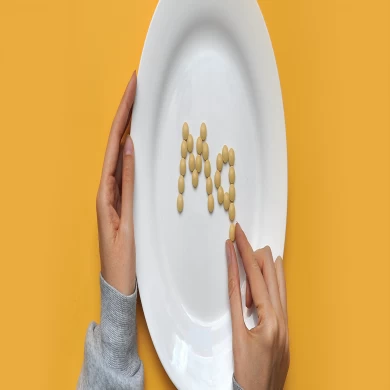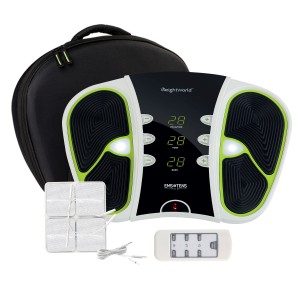All-Natural Supplements
GMP-certified and GMO-Free
Free UK Delivery
Enjoy free shipping on orders above £35
100% Customer Satisfaction
We offer a full 90-day money back guarantee

Fitness and Exercise
How to Better Circulation: Symptoms, Causes & Natural Remedies
10 Min. Read 04 Oct 2024
On this page
Proper blood circulation is key to maintaining overall well-being. When circulation is impaired, it can lead to various health issues, particularly in the arms and legs. That’s why understanding the symptoms and causes of poor circulation is crucial for addressing and preventing these problems.
Wondering, “How to better circulation?” In this piece, we'll learn about the signs of poor circulation, explore what causes poor blood circulation, and discuss effective treatments and natural remedies to improve circulation.
What Are the Poor Circulation Symptoms?
Good circulation ensures that oxygen and nutrients are efficiently delivered to the body's tissues and organs. However, poor circulation, especially in the extremities like the arms and legs, can result in a range of health complications. This condition, often overlooked until symptoms become severe, can affect anyone, regardless of age or lifestyle.
Before you learn how to better circulation, you first need to know about poor circulation symptoms. Poor circulation can manifest through various symptoms, often starting subtly and becoming more noticeable over time. Recognising these symptoms early can help in addressing the underlying issues promptly.
Here are some common poor circulation symptoms:
- Numbness and Tingling: A frequent sensation of numbness or tingling in the hands and feet.
- Cold Extremities: Persistently cold hands and feet, even in warm environments.
- Swelling: Unexplained swelling in the lower extremities.
- Pain and Cramps: Experiencing pain, cramping, or throbbing in the arms or legs, particularly during physical activity.
- Discolouration: Bluish or pale skin on the fingers or toes.
- Slow Healing: Cuts and sores on the legs or feet that heal slowly.
These signs of poor circulation can significantly impact daily activities and quality of life. If you notice any of these symptoms, it’s essential to consult a healthcare professional for an accurate diagnosis and appropriate treatment.
Causes of Poor Circulation
Understanding what causes poor blood circulation in the hands and feet is the first step towards prevention and treatment. Various factors can contribute to impaired blood flow in the arms and legs, including:
- Atherosclerosis: The build-up of plaque in the arteries, which narrows them and restricts blood flow.
- Peripheral Artery Disease (PAD): A common circulatory problem where narrowed arteries reduce blood flow to the limbs.
- Diabetes: High blood sugar levels can damage blood vessels and reduce circulation.
- Obesity: Excess weight puts additional pressure on the veins and arteries, impeding circulation.
- Sedentary Lifestyle: Lack of physical activity can lead to poor circulation, as regular movement helps blood flow.
- Smoking: Nicotine constricts blood vessels, reducing blood flow and oxygen delivery.
- Raynaud’s Disease: A condition causing some areas of the body, such as fingers and toes, to feel numb and cold in response to cold temperatures or stress.
Identifying and addressing these factors can help in managing and preventing improper blood circulation symptoms. By recognising the signs of poor circulation in hands and feet and understanding its causes, you can take proactive steps to improve your circulation and enhance your overall health.
What About Circulation Devices?
Now that you’re fully aware of the poor circulation symptoms and causes, wondering how to better circulation at home? That’s where a reliable circulation massager from a reputable brand can come to your assistance.
Vibration circulation massagers are gaining popularity for their effectiveness in preventing signs of poor circulation and improving blood flow in the arms and feet. These devices use gentle vibrations to stimulate muscle contractions, which in turn enhances circulation.
Here are some of the key benefits of using vibration circulation massagers:
1. Enhanced Blood Flow
Vibration massagers help to stimulate the blood vessels, promoting better circulation and ensuring that oxygen and nutrients are efficiently delivered to your extremities.
2. Reduced Swelling
By improving lymphatic drainage, these devices can help reduce swelling and fluid retention in the hands and feet.
3. Pain Relief
Regular use of vibration massagers can alleviate pain and discomfort associated with poor circulation, such as cramps and throbbing sensations.
4. Improved Muscle Function
The vibrations stimulate muscle activity, which can improve overall muscle tone and function, reducing the risk of muscle atrophy due to inactivity.
5. Relaxation and Stress Relief
In addition to physical benefits, vibration massagers can provide a soothing and relaxing experience, helping to reduce stress and tension.
6. Improved Flexibility
Regular use of vibration massagers can help increase the flexibility of muscles and joints by promoting better blood flow and reducing muscle stiffness.
7. Enhanced Recovery
Athletes and active individuals can benefit from quicker recovery times, as improved circulation helps to clear out metabolic waste and deliver nutrients needed for muscle repair.
8 Boosted Immune Function
Better circulation can support a stronger immune system by facilitating the efficient movement of white blood cells and other immune components throughout the body.
9. Detoxification
Enhanced blood flow helps to remove toxins from the body more effectively, promoting overall health and well-being.
10. Energy Boost
Improved circulation ensures that oxygen and nutrients are more efficiently delivered to muscles and tissues, which can help boost energy levels and reduce fatigue.
11. Improved Skin Health
Better blood flow can lead to healthier, more radiant skin by ensuring that skin cells receive adequate nutrients and oxygen.
When choosing a vibration circulation massager, always go for a reliable one from a reputable brand. High-quality devices are more likely to offer consistent performance and durability, ensuring you get the most benefit from your stment. Look for products with positive reviews and endorsements from healthcare professionals to ensure you're making a wise choice.
In short, incorporating a vibration circulation massager into your routine can be a highly effective way to improve blood flow, reduce poor circulation symptoms in your hands and feet, and enhance your overall well-being.
WeightWorld Foot Circulator
Why Choose It?
With its revolutionary EMS & TENS technology, this fitness device is perfect for stimulating tired muscles.
Our satisfied customers love it and have given this device an outstanding 4.5 out of 5 rating.
According to June B -
“It’s certainly making my legs less achy”
If you’re looking for other efficient devices for effective at-home workout sessions, you can try our Vibration Plate. We also offer a wide range of premium fitness supplements and devices if you wish to take your overall fitness game up a notch.
Diagnosing Poor Circulation
If you suspect poor circulation, seek medical advice without any delay. Healthcare professionals use various methods to diagnose poor circulation in hands and feet, including:
- Physical Examination: A thorough physical exam to check for poor circulation symptoms.
- Ankle-Brachial Index (ABI): A test comparing the blood pressure in the ankle with the blood pressure in the arm to detect PAD.
- Ultrasound: Imaging techniques to view blood flow and identify blockages or abnormalities in the blood vessels.
- Blood Tests: Tests to check for diabetes, cholesterol levels, and other conditions that might affect circulation.
Detecting a condition early can greatly enhance treatment success and avert potential complications.
Treating Poor Circulation
Once diagnosed, treating poor circulation in hands and feet involves a combination of medical interventions and lifestyle changes. Here are some common treatments:
- Medications: Drugs to manage underlying conditions such as diabetes, high blood pressure, and high cholesterol.
- Angioplasty: A procedure to widen or unblock narrowed blood vessels.
- Bypass Surgery: Establishing an alternative route for blood flow around a blocked artery.
- Lifestyle Changes: Adopting a healthier lifestyle, including regular exercise, a balanced diet, quitting smoking, and maintaining a healthy weight.
These treatments can help with poor blood circulation symptoms and improve overall well-being.
Natural Remedies
In addition to medical treatments, several natural remedies can help enhance blood flow and reduce poor circulation symptoms. Incorporating these remedies into your daily routine can promote better circulation:
- Exercise Regularly: Physical activity, especially aerobic exercises like walking, swimming, and cycling, can significantly improve blood flow.
- Stay Hydrated: Drinking plenty of water helps maintain blood volume and circulation.
- Healthy Diet: Consuming foods rich in antioxidants, omega-3 fatty acids, and vitamins C and E can support vascular health.
- Herbal Supplements: Some herbs, such as ginger, garlic, and ginkgo biloba, are known for their circulation-boosting properties.
- Massage: Regular massages can stimulate blood flow and reduce tension in the muscles.
These natural approaches can be effective in managing signs of poor circulation and enhancing overall health.
Final Say
Poor circulation in the arms and legs can lead to significant health issues if left untreated. By understanding poor circulation symptoms and their causes, you can take proactive steps to improve your circulation and overall well-being. Whether through medical treatments, lifestyle changes, or natural remedies, addressing circulation problems early can prevent complications and enhance your quality of life.
FAQ's
The signs of poor circulation include numbness and tingling in the extremities, cold hands and feet, swelling, pain or cramping in the limbs, and discolouration of the skin. Recognising these poor circulation symptoms early is essential for addressing underlying issues and finding ways to better circulation in your body.
A common cause of poor circulation is atherosclerosis, which involves plaque build-up in the arteries. This condition restricts blood flow and can lead to various improper blood circulation symptoms. Other factors include diabetes, obesity, and a sedentary lifestyle. Understanding what causes poor blood circulation can help in taking preventive measures.
Improving circulation can be achieved through regular exercise, staying hydrated, maintaining a healthy diet, and avoiding smoking. Using vibration circulation massagers can also help stimulate blood flow, particularly in the arms and feet. Knowing how to better circulation can significantly enhance your overall health.
A lack of circulation can be caused by conditions such as peripheral artery disease (PAD), diabetes, and Raynaud’s disease. These conditions can lead to poor circulation symptoms like numbness, cold extremities, and slow healing of wounds. Understanding what causes poor blood circulation is key to finding effective treatments and improving overall blood flow.
Sources
- https://www.ahajournals.org/doi/full/10.1161/01.ATV.16.7.851
- https://pubmed.ncbi.nlm.nih.gov/20592174/
- https://www.ncbi.nlm.nih.gov/pmc/articles/PMC2945176/
- https://pubmed.ncbi.nlm.nih.gov/27853158/
- http://w3.csmu.edu.tw/~chr/PDF/2001%20PAOD%20NEJM.pdf
- https://pubmed.ncbi.nlm.nih.gov/9546971/
- https://www.webmd.com/dvt/ss/slideshow-dvt-improve-circulation
- https://www.medicalnewstoday.com/articles/320793
- https://my.clevelandclinic.org/health/diseases/21882-poor-circulation

Next
On this page What Is Magnesium Glycinate? What Are the Benefits of Taking Magnesium Glycinate? How Much Magnesium Glycinate Should You Take per Day What Are the Best Magnesium Glycinate Supplements? 10 Common Magnesium Glycinate Side Effects Final Say FAQs...
Most Viewed Articles
7 Proven Health Benefits of Apple Cider Vinegar What Is Apple Cider Vinegar? What Are...
On this page What Are the Top Vitamin B12 Foods? What About Vitamin B12 Supplements?...
On this page What Is a Vibration Plate? Why Should I Do Vibration Plate Exercises?...










